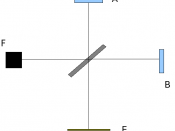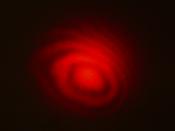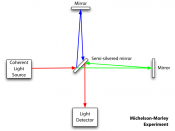There are some experiments throughout the history of physics that challenge the old system of thinking, while opening up doors for new ideas and progressions to be made. One such experiment is the Michelson and Morley experiment of the earth's velocity through "aether".
Albert Michelson and William Morley were two American physicists who worked in Cleveland, Ohio. They grew up in a time where scientists believed that the universe 'floated' in a special substance called aether. Nearly everyone, including Michelson and Morley, believed in aether's existence, so their experiment's outcome was extremely alarming.
19th century physicists determined that light is a wave, and inferred that it needed a medium to propagate through, just as sound waves and other mechanical waves do. This led them to believe in "aether" the fifth element that was originally thought of by Plato to explain hoe the planets remained in place. They could not prove the existence of aether, but determined that it:
o Filled all space
o Was perfectly transparent
o Had an extremely low density
o Could permeate all matter, just as all matter could permeate it
o Had great elasticity in order to propagate light at 3x108m/s
Michelson and Morley's experiment was designed to " observe the relative motion of the earth and the luminiferous ether" [from their published Aims].
Many experiments had attempted to do this, yet all were very inaccurate. According to Maxwell's electromagnetic theory, effects depending on (v/c)2 should have been detectable in optical and electrical experiments.
The thing that set Michelson and Morley's experiment out from the rest was the accuracy of their equipment. Michelson invented the "Michelson inferometer", which was capable of measuring very accurately differences in the phases of light waves.
Basically it involves the comparison of the velocity of light traveling in two mutually perpendicular...


